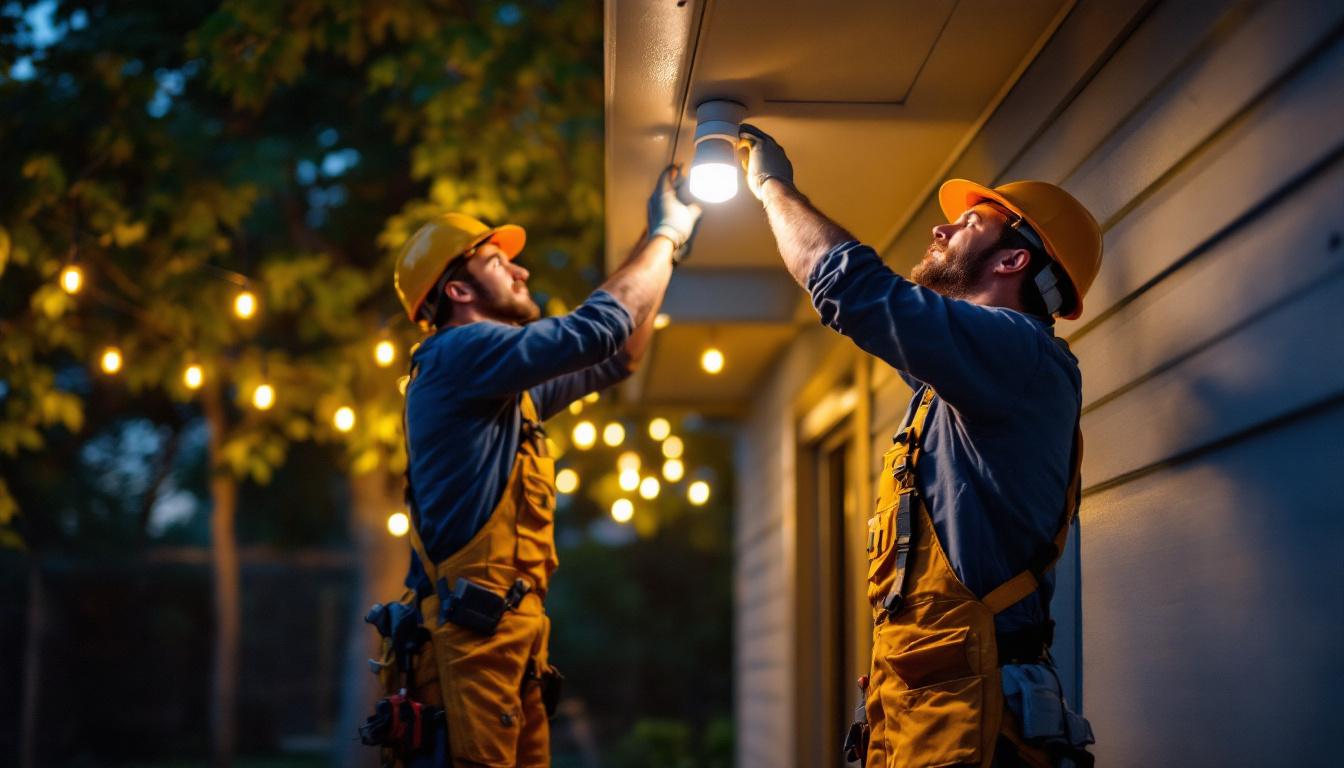
As the demand for energy-efficient and smart lighting solutions continues to grow, ceiling mount motion sensor lights have emerged as a popular choice for outdoor spaces. These lights not only enhance security but also improve the overall aesthetics of a property. For lighting contractors, understanding the intricacies of these fixtures is essential for delivering exceptional service to clients. This article provides valuable insights and tips for effectively installing and maintaining ceiling mount motion sensor lights outdoors.
Motion sensor lights utilize advanced technology to detect movement and activate illumination as needed. This feature is particularly beneficial for outdoor areas, where security and visibility are paramount. By understanding the different types of motion sensors, contractors can better advise clients on the best options for their specific needs. The integration of motion sensor technology not only enhances safety but also contributes to energy efficiency, reducing unnecessary power consumption by ensuring lights are only on when needed.
There are primarily two types of motion sensors used in outdoor lighting: passive infrared (PIR) sensors and microwave sensors. PIR sensors detect heat emitted by objects, making them effective for detecting human movement. On the other hand, microwave sensors emit microwave signals and can cover a larger area, detecting motion even through walls or obstructions. This capability makes microwave sensors particularly useful in environments where traditional line-of-sight detection may be compromised, such as in densely wooded areas or near fences.
Each type has its pros and cons. While PIR sensors are generally more cost-effective and energy-efficient, microwave sensors offer greater coverage and sensitivity. Contractors should assess the installation environment to determine which type of sensor will provide the best performance. For instance, in high-traffic areas, a combination of both sensor types may be employed to maximize coverage and minimize false alarms, ensuring that the lighting system is both effective and reliable.
When selecting ceiling mount motion sensor lights, several features should be taken into account. These include detection range, sensitivity settings, and light duration. A wider detection range is beneficial for larger outdoor spaces, while adjustable sensitivity allows for customization based on the environment. Additionally, features such as daylight sensitivity can prevent the lights from activating during daylight hours, further enhancing energy savings.
Furthermore, the duration of light activation can be set to meet the specific needs of the client. Some fixtures offer options for short bursts of light, while others can remain illuminated for extended periods. Understanding these features will enable contractors to provide tailored solutions that meet client expectations. Moreover, the integration of smart technology, such as app-controlled settings, allows users to adjust their lighting preferences remotely, adding an extra layer of convenience and modernity to outdoor lighting solutions. This adaptability not only enhances user experience but also opens up new possibilities for energy management and security monitoring, making motion sensor lights an essential component of contemporary outdoor design.
Proper installation is crucial for ensuring the optimal performance of ceiling mount motion sensor lights. Following best practices not only enhances functionality but also extends the lifespan of the fixtures.
Location is a critical factor in the effectiveness of motion sensor lights. Contractors should aim to install these fixtures in areas with a clear line of sight to potential movement. This often includes entry points, driveways, and pathways. Avoiding obstructions such as trees or walls can significantly improve sensor performance.
It is also important to consider the height at which the lights are mounted. Generally, a height of 8 to 12 feet is recommended for optimal detection. However, this may vary based on the specific sensor type and the surrounding environment. For instance, if the area is prone to high winds or heavy snowfall, adjusting the height may be necessary to prevent false triggers or damage to the fixtures.
In addition to height, the angle of the sensor should be adjusted to maximize coverage. A downward tilt can help capture movement from lower angles, which is particularly useful in residential settings where pets or children may be present. Furthermore, considering the time of day and seasonal changes can also influence the effectiveness of the installation, as shadows and varying light conditions can affect sensor performance.
Electrical wiring must be handled with care to ensure safety and compliance with local codes. Contractors should always turn off the power supply before beginning installation. Utilizing weatherproof junction boxes and connectors is essential for outdoor installations to prevent moisture-related issues.
Additionally, it is advisable to use a circuit breaker that can handle the load of the lighting fixtures. This not only protects the lights but also ensures the safety of the entire electrical system. It’s also wise to consider the use of surge protectors, especially in areas prone to electrical storms. These devices can safeguard the motion sensors from voltage spikes that could otherwise lead to malfunction or complete failure.
Moreover, when running wiring, it’s beneficial to use conduit to protect the cables from physical damage and environmental factors. This is particularly important in areas with heavy foot traffic or where landscaping activities may occur. Properly securing and organizing wiring can also facilitate easier maintenance and troubleshooting in the future.
Once the installation is complete, thorough testing is essential. Contractors should verify that the sensors are functioning correctly by walking through the detection zone to ensure the lights activate as intended. Calibration may be necessary to adjust sensitivity and duration settings based on the specific environment.
Regular testing and maintenance checks can help identify any issues early on, ensuring that the lights remain effective over time. This proactive approach can also enhance client satisfaction, as they will appreciate the reliability of their lighting system. It is also beneficial to educate clients on how to adjust settings themselves, empowering them to make minor tweaks as needed based on their daily routines or seasonal changes.
In addition to routine checks, contractors should recommend a schedule for periodic maintenance, which may include cleaning the sensors to remove dust or debris that could obstruct their functionality. This simple step can significantly enhance the longevity and performance of the motion sensor lights, ensuring they continue to serve their purpose effectively for years to come.
Regular maintenance is vital for ensuring the longevity and performance of ceiling mount motion sensor lights. Contractors should educate clients on the importance of upkeep and provide guidance on how to care for their lighting systems.
Dust, dirt, and debris can accumulate on motion sensor lights, affecting their performance. Regularly cleaning the fixtures with a soft cloth or sponge can help maintain optimal functionality. It is advisable to avoid harsh chemicals that may damage the surface of the lights.
In addition to cleaning the exterior, contractors should also recommend checking the sensor lenses for any obstructions. A clear lens is crucial for accurate motion detection, and any buildup should be promptly addressed.
Periodic inspections of the electrical components are essential for identifying any potential issues. Contractors should advise clients to check for loose connections, frayed wires, or signs of corrosion. Addressing these problems early can prevent more significant issues down the line.
Furthermore, replacing bulbs as needed is crucial for maintaining consistent illumination. Contractors should provide clients with information on the type of bulbs used and their expected lifespan, enabling them to plan for replacements effectively.
Ceiling mount motion sensor lights are not only practical but also serve as a deterrent against potential intruders. By strategically placing these lights, contractors can significantly enhance the security of residential and commercial properties.
Integrating motion sensor lights into a layered lighting approach can provide comprehensive coverage and enhance security. This involves combining different types of lighting, such as pathway lights, floodlights, and accent lights, to create a well-lit environment.
Contractors should assess the property layout and recommend a combination of fixtures that work harmoniously together. This not only improves visibility but also creates a welcoming atmosphere while deterring unwanted activity.
As technology continues to evolve, integrating smart features into motion sensor lighting systems has become increasingly popular. Smart motion sensor lights can be controlled remotely, allowing clients to adjust settings and receive notifications directly on their smartphones.
Contractors should stay informed about the latest smart lighting technologies and offer clients options that align with their preferences. This added convenience can greatly enhance the user experience and provide peace of mind.
While ceiling mount motion sensor lights offer numerous benefits, contractors may encounter challenges during installation or maintenance. Understanding these common issues and their solutions can help ensure a smooth process.
One of the most common issues with motion sensor lights is false triggering, where the lights activate without any actual movement. This can be caused by various factors, including wind, passing cars, or even small animals. Contractors should educate clients on how to adjust sensitivity settings to minimize false triggers.
In some cases, relocating the sensor or changing the angle of the fixture can also help reduce false activations. A thorough assessment of the installation site can help identify potential sources of interference.
Inconsistent performance can arise from several factors, including improper installation or environmental conditions. Contractors should ensure that the sensors are correctly calibrated and positioned to detect movement effectively.
Additionally, extreme weather conditions can impact sensor performance. Educating clients about the potential effects of rain, snow, or extreme temperatures can help manage expectations and encourage proactive maintenance.
Ceiling mount motion sensor lights are an excellent addition to outdoor spaces, providing both security and convenience. For lighting contractors, mastering the intricacies of these fixtures is essential for delivering exceptional service and ensuring client satisfaction.
By understanding motion sensor technology, adhering to installation best practices, and providing ongoing maintenance support, contractors can create effective lighting solutions that meet the diverse needs of their clients. As the demand for energy-efficient and smart lighting continues to rise, staying informed about the latest trends and technologies will position contractors for success in this evolving industry.
Ready to elevate your lighting projects with the finest ceiling mount motion sensor lights? Look no further than LumenWholesale. Our commitment to quality and affordability ensures you have access to the best spec-grade lighting products without the premium price tag. With LumenWholesale, you can confidently meet your clients’ needs, knowing you’re backed by reliability and performance. Take advantage of our hassle-free bulk buying and free shipping to get your superior lighting solutions. Don’t let hidden fees dim your project’s potential. Choose Wholesale Lighting at the Best Value and light up your outdoor spaces with efficiency and style.

Discover the ultimate guide for lighting contractors on selecting the best heavy-duty outdoor string lights.

Discover the ultimate guide to T Bar lighting with insights from top lighting contractors.

Discover how shatter resistant light bulbs can revolutionize your lighting projects by enhancing safety, reducing maintenance, and boosting overall efficiency.

Discover the essential resources lighting contractors rely on to master electric cord management.